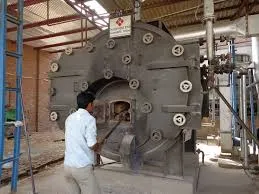
Nov . 21, 2024 04:59 Back to list
how does an oil fired boiler work
How Does an Oil Fired Boiler Work?
An oil-fired boiler is an efficient and reliable heating system that uses oil as its fuel source to produce heat for residential and commercial applications. Understanding how these boilers work can help users optimize their performance and make informed choices regarding their heating needs.
At the core of an oil-fired boiler is the combustion process. The boiler is equipped with an oil burner that atomizes the liquid fuel into a fine mist. This atomization is critical as it allows for more efficient combustion. When the oil enters the burner, it's mixed with air and ignited using a spark or a flame. The result is a controlled combustion process that generates hot gases.
How Does an Oil Fired Boiler Work?
The heated water or steam is then distributed throughout the building via a network of pipes and radiators. In a hot water heating system, water is circulated through radiators or underfloor heating systems, providing comfortable warmth. Conversely, in a steam heating system, the steam travels through pipes and is condensed back into water, which returns to the boiler to be reheated.
how does an oil fired boiler work

Oil-fired boilers are often equipped with a thermostat, which allows for automatic control of the heating system. When the temperature in the building drops below the set point, the thermostat signals the burner to ignite. Once the desired temperature is reached, the burner shuts off, ensuring energy efficiency.
One of the key advantages of oil-fired boilers is their ability to generate a significant amount of heat quickly. Oil has a high energy content, meaning that relatively small amounts of fuel can produce substantial heat output. This feature makes oil-fired boilers particularly effective in colder climates or in large spaces that require rapid heating.
However, like any heating system, oil-fired boilers have their drawbacks. The primary concern is the reliance on oil as a fuel source. Fluctuating oil prices can impact heating costs, making budgeting and expense management more challenging for consumers. Additionally, the combustion of oil can produce emissions, including carbon dioxide, which are environmental considerations.
Maintenance is essential for optimizing the performance of an oil-fired boiler. Regular inspections, cleaning of the burner, and checking the fuel supply can prevent breakdowns and ensure efficiency. Homeowners should also consider the importance of proper ventilation and ensure that combustion air can adequately reach the burner.
In summary, oil-fired boilers are an effective heating solution, utilizing a well-honed combustion process to generate heat. By understanding how these systems work, users can appreciate the benefits and challenges associated with oil-fired heating. Proper maintenance and consideration of the fuel source's environmental impact will help ensure that oil-fired boilers remain a viable option for efficient home or commercial heating.
-
High-Efficiency Commercial Oil Fired Steam Boiler for Industry
NewsJul.30,2025
-
High-Efficiency Biomass Fired Thermal Oil Boiler Solutions
NewsJul.30,2025
-
High Efficiency Gas Fired Thermal Oil Boiler for Industrial Heating
NewsJul.29,2025
-
High-Efficiency Gas Fired Hot Water Boiler for Sale – Reliable & Affordable
NewsJul.29,2025
-
High Efficiency Biomass Fired Hot Water Boiler for Industrial and Commercial Use
NewsJul.29,2025
-
High-Efficiency Biomass Fired Hot Water Boiler for Industrial Use
NewsJul.28,2025
Related PRODUCTS






















